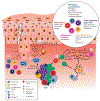Skin-Associated B Cells in Health and Inflammation
- PMID: 30833422
- PMCID: PMC6402607
- DOI: 10.4049/jimmunol.1801211
Skin-Associated B Cells in Health and Inflammation
Abstract
Traditionally, the skin was believed to be devoid of B cells, and studies of the skin immune system have largely focused on other types of leukocytes. Exciting recent data show that B cells localize to the healthy skin of humans and other mammalian species with likely homeostatic functions in host defense, regulation of microbial communities, and wound healing. Distinct skin-associated B cell subsets drive or suppress cutaneous inflammatory responses with important clinical implications. Localized functions of skin-associated B cell subsets during inflammation comprise Ab production, interactions with skin T cells, tertiary lymphoid tissue formation, and production of proinflammatory cytokines but also include immunosuppression by providing IL-10. In this review, we delve into the intriguing new roles of skin-associated B cells in homeostasis and inflammation.
Copyright © 2019 by The American Association of Immunologists, Inc.
Figures


Similar articles
-
IgM Plasma Cells Reside in Healthy Skin and Accumulate with Chronic Inflammation.J Invest Dermatol. 2019 Dec;139(12):2477-2487. doi: 10.1016/j.jid.2019.05.009. Epub 2019 May 30. J Invest Dermatol. 2019. PMID: 31152755 Free PMC article.
-
Innate lymphoid cells in allergic and nonallergic inflammation.J Allergy Clin Immunol. 2016 Nov;138(5):1253-1264. doi: 10.1016/j.jaci.2016.09.011. J Allergy Clin Immunol. 2016. PMID: 27817797 Review.
-
The microbiota in adaptive immune homeostasis and disease.Nature. 2016 Jul 7;535(7610):75-84. doi: 10.1038/nature18848. Nature. 2016. PMID: 27383982 Review.
-
Regulatory cells in the skin: Pathophysiologic role and potential targets for anti-inflammatory therapies.J Allergy Clin Immunol. 2019 Apr;143(4):1302-1310. doi: 10.1016/j.jaci.2018.12.1011. Epub 2019 Jan 18. J Allergy Clin Immunol. 2019. PMID: 30664891 Review.
-
Allergic contact dermatitis.Curr Dir Autoimmun. 2008;10:1-26. doi: 10.1159/000131410. Curr Dir Autoimmun. 2008. PMID: 18460878 Review.
Cited by
-
Immunology of Acute and Chronic Wound Healing.Biomolecules. 2021 May 8;11(5):700. doi: 10.3390/biom11050700. Biomolecules. 2021. PMID: 34066746 Free PMC article. Review.
-
Toward Understanding Wound Immunology for High-Fidelity Skin Regeneration.Cold Spring Harb Perspect Biol. 2022 Jul 1;14(7):a041241. doi: 10.1101/cshperspect.a041241. Cold Spring Harb Perspect Biol. 2022. PMID: 35667792 Free PMC article. Review.
-
Resident Memory B Cells.Viral Immunol. 2020 May;33(4):282-293. doi: 10.1089/vim.2019.0141. Epub 2020 Feb 5. Viral Immunol. 2020. PMID: 32023188 Free PMC article. Review.
-
Exploiting Unique Features of Microneedles to Modulate Immunity.Adv Mater. 2023 Dec;35(52):e2302410. doi: 10.1002/adma.202302410. Epub 2023 Nov 5. Adv Mater. 2023. PMID: 37380199 Free PMC article. Review.
-
Single-cell RNA sequencing reveals the expansion of circulating tissue-homing B cell subsets in secondary acute dengue viral infection.Heliyon. 2024 Apr 26;10(10):e30314. doi: 10.1016/j.heliyon.2024.e30314. eCollection 2024 May 30. Heliyon. 2024. PMID: 38818157 Free PMC article.
References
-
- Lian CG a. M. G. F. 2015. Histology of the Skin In Lever’s Histopathology of the Skin, 11 ed Elder DE, ed. Wolters Kluwer, Philadelphia: 8–75.
-
- Schön MP, Zollner TM, and Boehncke WH. 2003. The molecular basis of lymphocyte recruitment to the skin: clues for pathogenesis and selective therapies of inflammatory disorders. J. Invest. Dermatol 121: 951–962. - PubMed
-
- Pasparakis M, Haase I, and Nestle FO. 2014. Mechanisms regulating skin immunity and inflammation. Nat. Rev. Immunol 14: 289–301. - PubMed
Publication types
MeSH terms
Grants and funding
LinkOut - more resources
Full Text Sources

